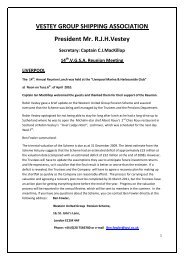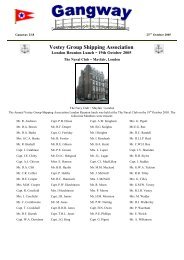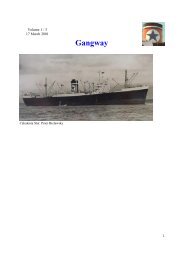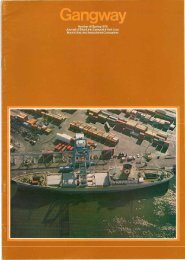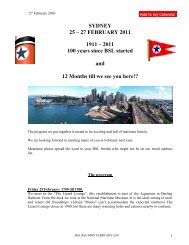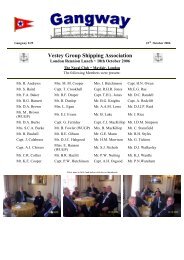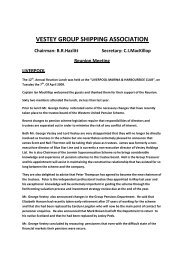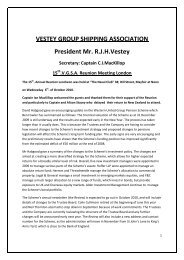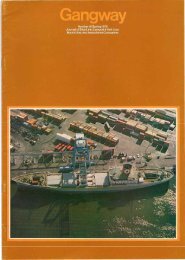Gangway No.1 Spring 1976 - BlueStarLine.org
Gangway No.1 Spring 1976 - BlueStarLine.org
Gangway No.1 Spring 1976 - BlueStarLine.org
You also want an ePaper? Increase the reach of your titles
YUMPU automatically turns print PDFs into web optimized ePapers that Google loves.
News from<br />
Australia<br />
Visitors<br />
The preceding three months have been<br />
rather quiet, W F La mbert of Blue Star<br />
Port Lines, Wellington, NZ was our only<br />
overseas visitor.<br />
Office happenings<br />
Barbara Kendrick has left us, and her<br />
place at the book-keeping machine has<br />
been taken by R ob yn Wal1ace.<br />
Dor een Darga n of our Accounts<br />
Department received a colourful bouquet<br />
of flowers to mark 25-years' service with<br />
Port Line, Joint Cargo Services, and Blue<br />
Star L ine. DOfeen is an avid stamp<br />
collector and regularly swaps Australian<br />
stamps with her colleagues in the London<br />
office.<br />
The PorI of Brisbane slory<br />
A little bit of history<br />
Back in the early 18205 the Brits decided it<br />
was time to establish a branch office away<br />
from Sydney. They were particularly<br />
interested in that big, empty hunk of<br />
unknown land up North. They were concerned---or<br />
so the story goes-that those<br />
hordes of people in South East Asia might<br />
sweep down and seize the land before they<br />
could officially 'acquire' it for King and<br />
Empire from the local population.<br />
British diplomacy being what it was in<br />
those days no one got around to telling the<br />
aforesaid local population that there was<br />
going to be a change in management. CA<br />
mere technicality, old boy', one admiral<br />
was heard to splutter.)<br />
The bloke they sent north was named<br />
Oxley. He was a product of the Royal Navy<br />
and British to the yardarm. It showed<br />
through in everything he did. For instance,<br />
when he sailed into Moreton Bay he<br />
automatically headed for the most inhospitable<br />
spot for a settlement. He worked<br />
on the premise that he probably wouldn't<br />
have to live in the joint-so why should he<br />
care?<br />
High motives<br />
With these high and mighty motives to<br />
urge him ever forward, he spurned more<br />
promising foreshore sites and bumped his<br />
boat over the sand, mud and rock bars at<br />
30 years old and still going srrong<br />
One for the engineers<br />
We found this British-built Lister twin<br />
cylinder diesel engine at Mookerawa, near<br />
Wellington, NSW. It was installed in 1946,<br />
and has not required a single service or<br />
repair during its 30-year life.<br />
The unit is fixed permanently to a tree<br />
fork which is then bolted to a concrete<br />
foundation. It is a simple matter to free<br />
the unit, whip a rope around the fork, and<br />
tow it to a new location. The engine is<br />
kept in constant use pumping water for<br />
irrigation and milling timber.<br />
the mouth of the Brisbane River and<br />
resolutely headed upstream.<br />
Oxley obviously came from the Nelson<br />
school of thought, which held that 'if you<br />
can't see it, it won't hurt you'. So, he<br />
turned his back on the noise of rattling<br />
spears and scorned the unwanted attention<br />
of the swarms of flies, mosquitoes, sandflies,<br />
and bities.<br />
14 or 15 miles upstream, he ordered the<br />
anchor to be tossed overboard, sent one of<br />
the braver crew members ashore to hoist<br />
the flag, and announced to the world:<br />
'It's time for my afternoon tea. This is as<br />
far as I bloody well go'.<br />
The year was 1824 and Brisbane was on<br />
the map!<br />
The Port of Brisbane today<br />
Today Brisbane is a major port of national<br />
and international importance, with a population<br />
rapidly approaching the one million<br />
mark. I t is the capital of Queensland and<br />
the third largest city in Australia.<br />
Brisbane is about midway between the<br />
northern (Cape York, Queensland) and<br />
southern (South Cape, Tasmania) extremities<br />
of Australia's eastern sea-board. The<br />
climate is pleasant sub-tropical. A low<br />
(winter) temperature would be 10°C, and<br />
the maximum (s ummer) is usually about<br />
2SoC to 29°C.<br />
Early port facilities were established well<br />
upstream, close to the heart of the growing<br />
Ignition!<br />
With valves lifted, the engine is swung<br />
at a fair rate: at a call, the right cylinder is<br />
given compression and invariably fires first<br />
time. The left is then dropped in and away<br />
she goes, with the operator disappearing<br />
in a cloud of black smoke.<br />
These engines are used far and wide<br />
throughout Australia fo r many jobs, though<br />
principally as a source of power in shearing<br />
sheds. Surprisingly enough, even in the<br />
heat of summer and after eight hours<br />
continuous operation, the water tank<br />
remains relatively cool at the intake level.<br />
city. However, with each succeeding<br />
generation, the port, its wharves, sheds,<br />
and general facilities have edged further<br />
downstream.<br />
At the moment, the main port activity is<br />
centred on the Hamilton and Bulimba<br />
reaches ofthe river, about 15 km upstream.<br />
Port limits embrace the whole of Moreton<br />
Bay (about 2700 square km) and the<br />
navigable waters of the rivers and creeks<br />
communicating with it. The port is<br />
managed and operated by the Port of<br />
Brisbane D ivision of the Harbours and<br />
Marine Department.<br />
36 berths<br />
There are 36 berths in the port, providing<br />
about 5500 m of wharf frontage. These<br />
wharves are mostly operated by private<br />
companies and include 16 for general cargo,<br />
a container terminal, three container/Ro<br />
Ro terminals, seven for oil and petroleum<br />
products, two for bulk handling of grain,<br />
two fo r meat, one for cold storage, two for<br />
chemicals and fertilisers, and two more for<br />
repair work.<br />
The port handles between 1300 and 1400<br />
ships a year and total cargo movement is<br />
increasing steadily. Blue Star Line ships<br />
are frequent visitors. They service several<br />
routes and are linked to important trade<br />
partners and pacts, working under such<br />
names as PACE, ACT A-ANL, and Blue<br />
Star/Salen Reefe r. These services bring



